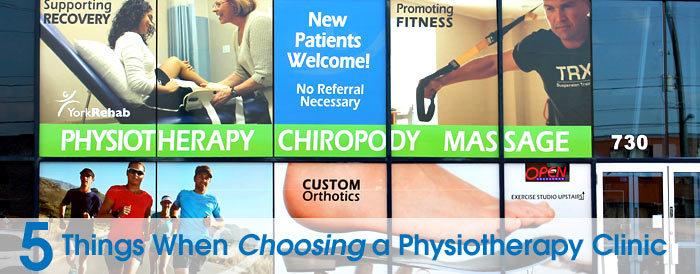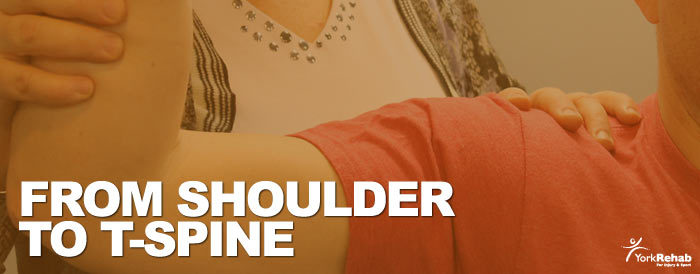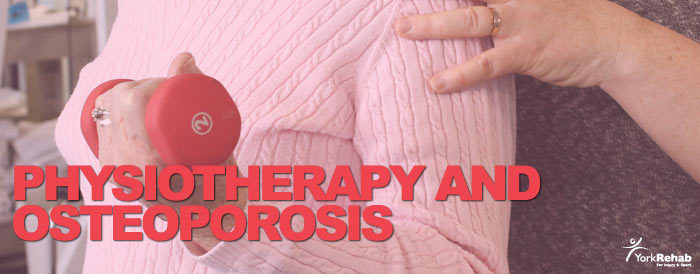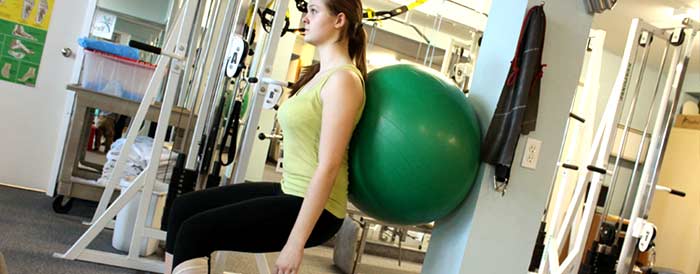Benefits of Physiotherapy
5 Things to Consider When Choosing a Physiotherapy Clinic
If you’re in need of a Physiotherapist in Newmarket you’re obviously going to want to find a therapist that will provide great treatment. The way you usually find a reputable Physiotherapist, is by finding a reputable clinic. With so many clinics out there, how do you find a “good” one? Every clinic will likely say they are a “good” clinic, but “good” can be subjective. Here are 5 objective considerations to help you find a physiotherapy clinic in Newmarket (or your local area) that will provide you with reputable treatment.
Convenient Hours
Putting the patient first is a good sign that you’ll be receiving proper treatment. One of the ways of putting the patient first is by offering early morning and evening appointments. The convenience of coming before or after work can be a huge benefit for those who badly need treatment but don’t have the flexibility to make an appointment during their work day. Our Newmarket physiotherapy clinic offers appointments as early as 8:00am and as late as 7:30pm. In addition to convenience, quality care also requires time – some clinics see patients in 15-minute blocks. Our physiotherapists complete 1-hour initial assessments, with 30 min follow up appointments.
Private Treatment Rooms
Having a private room allows you to: feel comfortable working with the physiotherapist; discuss your condition candidly and ask questions without fear of being overheard; learn your recovery exercises in privacy and allows focused (distraction free) interaction with your therapist. While private rooms are not standard at all clinics, they are available at York Rehab’s Newmarket physio clinic.
Ethical Billing
This means developing a treatment plan and schedule based on the needs of your condition, not your available coverage. Some clinics unethically design treatment plans around maximizing a patient’s coverage. Rather than scheduling the maximum number of visits that your coverage allows, York Rehab assesses your condition and develops a treatment plan to meet your needs. This practice saves you from unnecessary treatment sessions and means if you sustain another injury or re-injure yourself, you might still have coverage available.
Registered Physiotherapists
Beware, there are facilities that market themselves as offering physio (i.e. recovery exercises). However, that is not the same as being treated by a registered physiotherapist. Before you begin any type of treatment it’s important to have a thorough assessment completed by a licensed physiotherapist. This will prevent injury and speed up your recovery. All the physiotherapists at our Newmarket physiotherapy clinic are licensed physiotherapists.
One-on-One Ratio
Every appointment at York Rehab is exclusively delivered by a physiotherapist. Some clinics book multiple patients into a single time slot with one physiotherapist. In this scenario, the therapist makes and initial appearance then hands over the patient to a physio assistant. The assistant might then administer a treatment such as ultrasound or electric shock therapy, while the physiotherapist steps away to see another patient(s). Although an assistant is capable of administering such treatment, the patient is better served by the presence of a physiotherapist who can directly observe how the patient is receiving treatment and be available to answer questions or concerns the patient may be having during their recovery process – an assistant is not permitted to provide any type of medical consultation.
If you have any questions about the above list or you would like to book an appointment feel free to give us a call, we’d be happy to assist in whatever way we can.
8 Things We Bet You Don’t Know About Physiotherapists
You have probably heard about physiotherapy and have a general idea about what it is. But how much do you know about physiotherapists? Here are some things you probably don’t know about us:
- Recovery is our focus, not maintenance. Our goal is to help you feel better as quickly as possible and get you on the road to recovery while minimizing the number of return visits.
- You don’t need a doctor’s referral to see a Physiotherapist – if you think you need to see a Physio, give a clinic near you a call and discuss your needs. If you have health insurance, be sure to check and see what your insurer requires and covers since most physiotherapy is not covered by OHIP.
- We are university educated healthcare professionals. In addition to completing an undergraduate degree, along with a Master’s Degree in Physiotherapy, we must pass a comprehensive oral and written exam that we only have three chances to pass – three unsuccessful attempts leads to choosing another career. After successfully acquiring our degree and completing the exam, then and only then can we legally use the title Physiotherapist. Be aware that some injury care providers offer physiotherapy but it’s important to note that someone who says they do physiotherapy is not necessarily a Physiotherapist.
- We know body mechanics really well! By observing some of your basic movements we can determine what exercises you need to do to become better at your sport, reduce injury and even recommend activities you can begin if you’d like to become more active and find your stride in a regular activity or sport.
- We are not just about helping you recover from aches and pains. We are also an integral part of recovery after heart surgery, we provide treatment for lung conditions (like chronic bronchitis, asthma, emphysema or pneumonia) and we can help manage neurological conditions (i.e. Parkinson’s and MS).
- Babies are our patients too! When babies are born with minor muscular issues such as torticollis, we can help. Torticollis is a condition of the neck that happens when a major muscle called the sternocleidomastoid becomes shortened or contracted. This shortening causes the baby’s head to be fixed in a tilted position. By gently stretching the affected muscle, educating parents about proper head bolster positioning and teaching at-home stretches and strengthening exercises, we can help speed up recovery and minimize long-term complications. Pediatric Physiotherapists can also assess your child to ensure he/she is meeting their physical developmental milestones.
- We can help new moms overcome diastasis recti, bladder incontinence, low back pain and pelvic floor disability. Many new moms feel that these postnatal concerns are something that they will have to live with or are normal. But there is nothing normal about incontinence or consistent pain, and a physiotherapist can help retrain and strengthen these weak muscles.
- Acupuncture can be part of a physiotherapy treatment plan as it helps promote healing, reduce or relieve pain and improve function of the affected area of the body. The practice of acupuncture is learned through a specialized training program completed after earning a Physiotherapy designation.
From Shoulder to T-Spine: Become Unconsciously Competent
York Rehab’s Physiotherapists Jen Bladon did a guest post (May 14, 2014) for the move-everywhere.com website, whose mission is to develop an elite health and fitness conference for allied health, fitness and sports medicine professionals. Jen’s article focused on the shoulder along with its complexities and dependencies. You can read Jen’s article here.
Can Physiotherapy Help People with Osteoporosis?
Osteoporosis is a condition which affects millions of North Americans and millions more are at risk. Osteoporosis, which means “porous bone” is characterized by decreased bone density and structural deterioration of the bone. As a result the bones become weak and brittle. This brittleness can then result in bones that can fracture much more easily than normal. For example, fractures may occur with just coughing or sneezing, bending over, or lifting. The fractures typically occur in the hips, spine, or wrists. Women are four times more likely to develop the condition than men.
In most cases of osteoporosis, the bones weaken when you have low levels of calcium, phosphorous and other minerals in your bones. Many more individuals may have low bone density (osteopenia) and are at risk of developing osteoporosis. Your bone density can be evaluated by a bone density test.
An important factor in decreasing the risk of developing osteoporosis is ensuring your diet includes adequate vitamin D and calcium. And even if you already have the condition, it can help to prevent bones from getting weaker. Exercise, especially weight bearing exercises, in the first two decades of life is the best way to ensure you develop good levels of bone density because as we age our bone density will gradually decrease. So if you don’t have good density to begin with, you are greater risk later on.
Nevertheless, exercising throughout life is an important way to keep your bones stronger. The best exercises include strength training, weight bearing, and flexibility. Strength training consists of using resistance (eg. free weights, resistance bands, weight machines etc.) to build muscles. In particular, the arm muscles and posture muscles. Weight-bearing exercises slow down mineral loss in the bones and include activities such as walking, dancing, and hiking. Flexibility exercises help to maintain joint and muscle mobility and this in turn improves posture as well as balance. Improving balance decreases the risk of falls which can easily cause fractures in osteoporotic bone.
If you have osteoporosis it is a good idea to consult your physician to determine the severity through a bone density test before embarking on any exercise program .A physiotherapist can then assist you to develop an appropriate and safe program. In general, individuals with osteoporosis should avoid high impact activities such as running, and jumping. As well, exercises that involve bending and twisting, such as touching your toes, rowing machines, and full sit-ups, should be avoided as they increase the risk of compression fractures in the spine.
Physiotherapy can make you stronger
“Physiotherapy can make you stronger in so many ways.” This phrase is front and centre on the Ontario Physiotherapy Association’s facebook site. With so many tools in our toolbox, our role at York Rehab is to help improve your pain and function, as well as improve the quality of your life! The team at York Rehab is committed to help you recover from injury, learn how to prevent injury, and improve all aspects of your fitness and health.
As described by the Canadian Physiotherapy Association, physiotherapy is rooted in movement sciences, using both a holistic and individualized approach. With extensive experience in post-graduate course work, the York Rehab team offers an assessment and treatment approach that is evidence based – meaning our therapy ensures the most optimal care and outcomes. Just as our degree program in Physical Therapy was completed within a Faculty of Medicine, our continuing education allows us to assume an important role within your health care team.
At York Rehab, we provide a treatment approach that uses specifically designed exercises unique to each patient, manual therapy, and various physiotherapy modalities (such as ultrasound, acupuncture, biofeedback). As the Canadian Academy of Manipulative Therapists explains: Manual therapists are well trained to use their hands to diagnose and treat limitations in movement in the spine, arms and legs. Using gentle, hands-on techniques, we can help reduce muscle tightness, improve movement in the joints, reduce pain and improve function.
Did you know that we are also trained in joint manipulation? A joint manipulation is a passive high velocity (quick) low amplitude (small) thrust that is applied to a joint beyond its physiological limit of motion, but within its anatomical limit – intended to restore optimal motion, function and/or reduce pain. Well within our scope (or skill) of practice, and regulated by The College of Physiotherapists of Ontario, physiotherapists use manipulations selectively – when the assessment, clinical experience, evidence, and patient consent indicate it is the best treatment approach. Our manipulation techniques are extensions of our mobilizations, and isolated and localized to a specific direction. In fact, we often use a distractive technique that can offer immediate relief without torque, twist or strain.
Both Bob Lyeo and Jen Bladon are Fellows with the Canadian Academy of Manipulative Therapists in Canada, whereas Ann Botham, Fiona MacKenzie, and Liisa Ruomo-Reddy are credentialed MacKenzie therapists. Having completed rigorous training, mentorship hours, and qualifying examinations, their practice also includes safe and effective spinal manipulations. When identified as an effective and necessary tool – after thorough assessment and in addition to therapeutic exercise and education – manual therapy and safe manipulation practices are an integral part of the York Rehab approach –towards recovery and a stronger you. :)
As analytical and movement experts, you are in good hands at York Rehab!!










